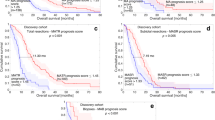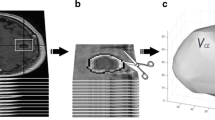Abstract
In this retrospective, IRB-exempt study, we analyzed data from 68 patients diagnosed with glioblastoma (GBM) in two institutions and investigated the relationship between tumor shape, quantified using algorithmic analysis of magnetic resonance images, and survival. Each patient’s Fluid Attenuated Inversion Recovery (FLAIR) abnormality and enhancing tumor were manually delineated, and tumor shape was analyzed by automatic computer algorithms. Five features were automatically extracted from the images to quantify the extent of irregularity in tumor shape in two and three dimensions. Univariate Cox proportional hazard regression analysis was performed to determine how prognostic each feature was of survival. Kaplan Meier analysis was performed to illustrate the prognostic value of each feature. To determine whether the proposed quantitative shape features have additional prognostic value compared with standard clinical features, we controlled for tumor volume, patient age, and Karnofsky Performance Score (KPS). The FLAIR-based bounding ellipsoid volume ratio (BEVR), a 3D complexity measure, was strongly prognostic of survival, with a hazard ratio of 0.36 (95% CI 0.20–0.65), and remained significant in regression analysis after controlling for other clinical factors (P = 0.0061). Three enhancing-tumor based shape features were prognostic of survival independently of clinical factors: BEVR (P = 0.0008), margin fluctuation (P = 0.0013), and angular standard deviation (P = 0.0078). Algorithmically assessed tumor shape is statistically significantly prognostic of survival for patients with GBM independently of patient age, KPS, and tumor volume. This shows promise for extending the utility of MR imaging in treatment of GBM patients.




Similar content being viewed by others
References
States CBTR of the U (2010) CBTRUS statistical report: primary brain and central nervous system tumors diagnosed in the United States in 2004–2006
Stupp R, Mason W, Bent M et al (2005) Radiotherapy plus concomitant and adjuvant temozolomide for glioblastoma. N Engl J Med 9(3):987–996. doi:10.1016/j.canrad.2005.05.001
Dobes M, Khurana V, Shadbolt B et al (2011) Increasing incidence of glioblastoma multiforme and meningioma, and decreasing incidence of Schwannoma. Surg Neurol Int 2(176):1–22. doi:10.4103/2152
Phillips HS, Kharbanda S, Chen R et al (2006) Molecular subclasses of high-grade glioma predict prognosis, delineate a pattern of disease progression, and resemble stages in neurogenesis. Cancer Cell 9(3):157–173. doi:10.1016/j.ccr.2006.02.019
Verhaak R, Hoadley K, Purdom E et al (2010) Integrated genomic analysis identifies clinically relevant subtypes of glioblastoma characterized by abnormalities in PDGFRA, IDH1, EGFR, and NF1. Cancer Cell 17(1):98–110. doi:10.1016/j.ccr.2009.12.020
Czarnek NM, Clark K, Peters KB, Collins LM, Mazurowski MA (2016) Radiogenomics of glioblastoma: a pilot multi-institutional study to investigate a relationship between tumor shape features and tumor molecular subtype. In: Tourassi GD, Armato SG (eds) SPIE, Medical Imaging, p 97850 V. doi:10.1117/12.2217084
Hegi ME, Diserens A-C, Gorlia T et al (2005) MGMT gene silencing and benefit from temozolomide in glioblastoma. N Engl J Med 352(10):997–1003. doi:10.1056/NEJMoa043331
Yan H, Parsons DW, Jin G et al (2009) IDH1 and IDH2 mutations in gliomas. N Engl J Med 360(8):765–773. doi:10.1056/NEJMoa0808710
Belden CJ, Valdes P a., Ran C et al (2011) Genetics of glioblastoma: a window into its imaging and histopathologic variability. Radiographics 31(6):1717–1740. doi:10.1148/rg.316115512
Iliadis G, Kotoula V, Chatzisotiriou A et al (2012) Volumetric and MGMT parameters in glioblastoma patients: Survival analysis. BMC Cancer 12(1):3. doi:10.1186/1471-2407-12-3
Aghi M, Gaviani P, Henson JW, Batchelor TT, Louis DN, Barker FG (2005) Magnetic resonance imaging characteristics predict epidermal growth factor receptor amplification status in glioblastoma. Clin Cancer Res 11(24):8600–8605. doi:10.1158/1078-0432.CCR-05-0713
Ramakrishna R, Barber J, Kennedy G et al (2010) Imaging features of invasion and preoperative and postoperative tumor burden in previously untreated glioblastoma: correlation with survival. Surg Neurol Int 1(40):1–22. doi:10.4103/2152
Ekici MA, Bulut T, Tucer B, Kurtsoy A (2011) Analysis of the mortality probability of preoperative MRI features in malignant astrocytomas. Turkish neurosurg 21:271–279
Gutman DA, Cooper LA, Hwang SN et al (2013) MR imaging predictors of molecular profile and survival: multi-institutional study of the TCGA glioblastoma data set. Radiology 267(2):560–569. doi:10.1148/radiol.13120118
Jain R, Poisson L, Narang J et al (2013) Genomic mapping and survival prediction in glioblastoma: molecular subclassification strengthened by hemodynamic imaging biomarkers. Radiology 267(1):212–220. doi:10.1148/radiol.12120846
Mazurowski MA, Desjardins A, Malof JM (2013) Imaging descriptors improve the predictive power of survival models for glioblastoma patients. Neuro Oncol 15(10):1389–1394
Cordova JS, Schreibmann E, Hadjipanayis CG et al (2014) Quantitative tumor segmentation for evaluation of extent of glioblastoma resection to facilitate multisite clinical trials. Transl Oncol 7(1):40–47. doi:10.1593/tlo.13835
Nicolasjilwan M, Hu Y, Yan C et al (2015) Addition of MR imaging features and genetic biomarkers strengthens glioblastoma survival prediction in TCGA patients. J Neuroradiol 42(4):212–221
Cordier D, Forrer F, Kneifel S et al (2010) Neoadjuvant targeting of glioblastoma multiforme with radiolabeled .DOTAGA-substance P—results from a phase I study. J Neurooncol 100(1):129–136. doi:10.1007/s11060-010-0153-5
Albert F, Forsting M, Sartor K, Adams H, Kunze S (1994) Early postoperative magnetic resonance imaging after resection of malignant glioma: objective evaluation of residual tumor and its influence on regrowth and prognosis. Neurosurgery 34(1):45–61
Gevaert O, Mitchell L A, Achrol AS et al (2014) Glioblastoma multiforme: exploratory radiogenomic analysis by using quantitative image features. Radiology 273(1):168–174. doi:10.1148/radiol.14131731
Wangaryattawanich P, Hatami M, Wang J et al (2015) Multicenter imaging outcomes study of The Cancer Genome Atlas glioblastoma patient cohort: imaging predictors of overall and progression-free survival. Neuro Oncol. doi:10.1093/neuonc/nov117
Macyszyn L, Akbari H, Pisapia JM et al (2015) Imaging patterns predict patient survival and molecular subtype in glioblastoma via machine learning techniques. Neuro Oncol. doi:10.1093/neuonc/nov127
Itakura H, Achrol AS, Mitchell LA et al (2015) Magnetic resonance image features identify glioblastoma phenotypic subtypes with distinct molecular pathway activities. Sci Transl Med. doi: 10.1126/scitranslmed.aaa7582
Cui Y, Tha KK, Terasaka S et al (2016) Prognostic imaging biomarkers in glioblastoma: development and independent validation on the basis of multiregion and quantitative analysis. Radiology 0(0):1–8
Mazurowski MA, Czarnek NM, Peters KB, Clark KL (2016) Predicting outcomes in glioblastoma patients using computerized analysis of tumor shape: preliminary data. In: Tourassi GD, Armato SG (eds) SPIE Medical Imaging, p 97852T. doi:10.1117/12.2217098
Gatenby R, Grove O, Gillies R. Quantitative imaging in cancer evolution and ecology. Radiology. 2013;269(1)
Carlson MRJ, Pope WB, Horvath S et al (2007) Relationship between survival and edema in malignant gliomas: Role of vascular endothelial growth factor and neuronal pentraxin 2. Clin Cancer Res 13(9):2592–2598. doi:10.1158/1078-0432.CCR-06-2772
Silbergeld DL, Chicoine MR (1997) Isolation and characterization of human malignant glioma cells from histologically normal brain. J Neurosurg 86(3):525–531. doi:10.3171/jns.1997.86.3.0525
Pope WB, Sayre J, Perlina A, Villablanca JP, Mischel PS, Cloughesy TF (2005) MR imaging correlates of survival in patients with high-grade gliomas. Am J Neuroradiol 26(10):2466–2474 pii]
Lacroix M, Abi-Said D, Fourney DR et al (2001) A multivariate analysis of 416 patients with glioblastoma multiforme: prognosis, extent of resection, and survival. J Neurosurg 95(2):190–198. doi:10.3171/jns.2001.95.2.0190
Hammoud MA (1996) Prognostic significance of preoperative MRI scans in glioblastoma multiforme. J Neurooncol 27(1):65–73. doi:10.1007/BF00146086
Carrillo JA, Lai A, Nghiemphu PL et al (2012) Relationship between tumor enhancement, edema, IDH1 mutational status, MGMT promoter methylation, and survival in glioblastoma. Am J Neuroradiol 33(7):1349–1355. doi:10.3174/ajnr.A2950
Mazurowski MA, Zhang J (2014) Computer-extracted MR imaging features are associated with survival in glioblastoma patients. J Neurooncol 1:483–488. doi:10.1007/s11060-014-1580-5
McLendon R, Friedman A, Bigner D et al (2008) Comprehensive genomic characterization defines human glioblastoma genes and core pathways. Nature 455(7216):1061–1068. doi:10.1038/nature07385
Moshtagh N (2005) Minimum volume enclosing ellipsoids. Convex Optim 111:112
Khachiyan LG (1980) Polynomial algorithms in linear programming. USSR Comput Math Math Phys 20(6):51–68
Pohlman S, Powell K a, Obuchowski N a, Chilcote W a, Grundfest-Broniatowski S (1996) Quantitative classification of breast tumors in digitized mammograms. Med Phys 23(8):1337–1345. doi:10.1118/1.597707
Giger ML, Vyborny CJ, Schmidt R a (1994) Computerized characterization of mammographic masses: analysis of spiculation. Cancer Lett 77(2–3):201–211. doi:10.1016/0304-3835(94)90103-1
Georgiou H, Mavroforakis M, Dimitropoulos N, Cavouras D, Theodoridis S (2007) Multi-scaled morphological features for the characterization of mammographic masses using statistical classification schemes. Artif Intell Med 41(1):39–55. doi:10.1016/j.artmed.2007.06.004
Funding
This material is based upon work supported by the National Science Foundation Graduate Research Fellowship under Grant No. 1106401. Any opinions, findings, and conclusions or recommendations expressed in this material are those of the authors and do not necessarily reflect the view of the National Science Foundation.
Author information
Authors and Affiliations
Corresponding author
Ethics declarations
Conflict of interest
Katherine B. Peters has served on advisory boards for Agios and Novocure and received research funding from Agios, AMGEN, BioMimetix, Eisai, Genentech, Merck, and VBL. None of the remaining authors have conflicts of interest to disclose.
Electronic supplementary material
Below is the link to the electronic supplementary material.
Rights and permissions
About this article
Cite this article
Czarnek, N., Clark, K., Peters, K.B. et al. Algorithmic three-dimensional analysis of tumor shape in MRI improves prognosis of survival in glioblastoma: a multi-institutional study. J Neurooncol 132, 55–62 (2017). https://doi.org/10.1007/s11060-016-2359-7
Received:
Accepted:
Published:
Issue Date:
DOI: https://doi.org/10.1007/s11060-016-2359-7




